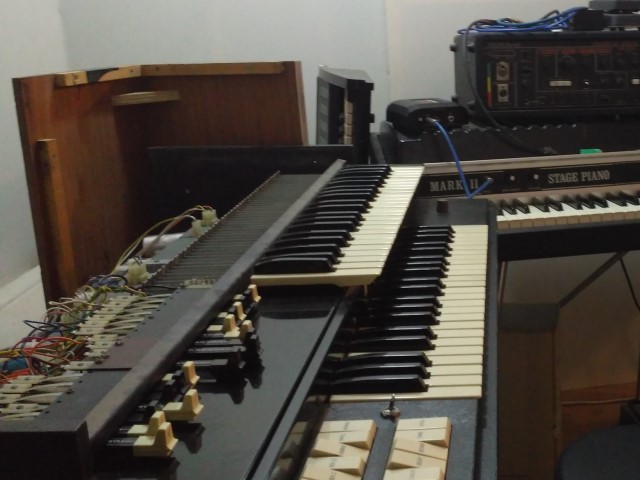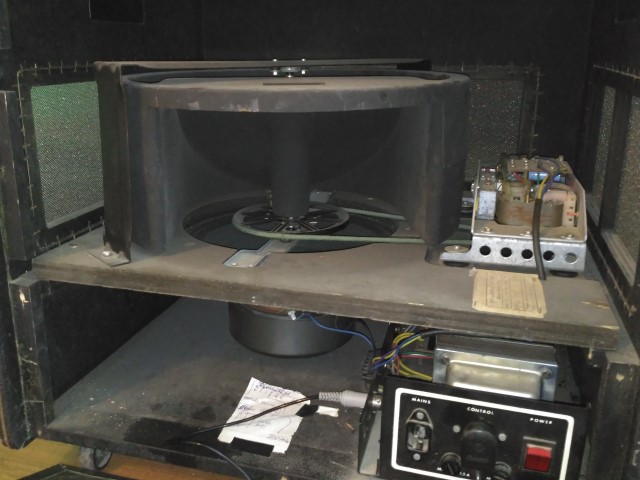My initial intention was to include this post in my “The Dark Side of Vintage Machines” series, but reflecting more, there really wasn’t anything dark on such a simple action as adding lubricant to this super heavy, but solid as a rock instrument, to bring it back to life!
I must admit that I’ve been lazy and recur to virtual instruments when I needed an organ sound, for too long even having the real thing. The plugins level of fidelity in reproducing the classic tonewheel sound, has reached an impressive level since a long time already. It might look like a sterile excercise, going back to record from the original instruments, when this process has been done with extreme care from team of experts several times in the last decades, to bring us such great sounding virtual instruments, so easy to use. An organ keyboard not being sensitive, can be imagined like a series of ON/OFF switches, this way the interaction with the instrument interface can be easily reproduced today, using a simple MIDI keyboard, better not weighted.
Bringing back my old Hammond to life, could have meant spending tens of hours of care and possible frustration, in case of unsuccess. I switched it off last time many years ago, when almost all of it was working, but it was already in urgent need of oiling its internal mechanism with the once rare to find, but now easily available on internet, “Hammond Oil”. Its rotating speaker amplifier, an Italian transistors pseudo “Leslie”, was in a horrible state too, roaring as a jet at take off, when switched on.

I could have avoided the stress of the repair once again, resisting to my conscience that was pushing me towards being more responsable and keep my instruments serviced, with the excuse that it is pointless to spend energy to have something only a little bit better sounding. This time I had a deep sense of nostalgy for my organ, who had been with me for almost all my life and I had loved so much and a sort of sense of responsability, towards this piece of technology of big mechanical complexity, possibly extremely difficult to manufacture again, today.
I don’t want to be too boring, just let me add a little story as it can be funny..or tragic? :D
My first organ was a transistors Farfisa, a way more technologically advanced machine, with respect to a classic tube organ like the Hammond, it could even emulate the gliding of a synth, with its “Synthslalom” function! :D I knew already the old electromechanical organs were particularly sweet sounding, but couldn’t imagine that even a humble spinet size keyboard like the L-100, was a real killer, able to recreate the sound of the progressive rock organs I was so crazy for, until I had to occasion to test an used one at a shop in my city. The price was extremely cheap, as nobody wanted to carry such a heavy “portable” instrument around, or buying for home an ugly looking keyboard with just organ sounds when, for the same money, they could have bought a huge wooden console full of colored lights, a drum machine and plenty of inspiring buttons like “Bassoon” or “Tuba”!
The occasion was great, but I was still a student and completely budgetless.
Making a formal promise to my parents that I would have been a very good student, I could convince them to finance the money the shop wanted. The thing worked and for a while I could enjoy playing day and night my real Hammond, through its amazingly sounding, wooden tube Leslie amplifier.
The day I knew I had failed school’s exams I was already in a horrible mood, this become a day of mourning, as soon as returning back home, I realized my Hammond had disappeared, brought back to the shop by my parents, as my promise to be a good student hadn’t been respected.
I’ve been lucky that prices remained pretty low for over a decade, until I could find one more “P” (this one is labelled L100PS), that having a job already, I could afford, the one I’m telling you about on this post.


instead of being a painful process, I found my Hammond, once oiled and switched back on for the first time after a decade, in a pretty good shape.
What resulted more problematic, was fixing the rotating speaker amplifier, that once on, used to start screaming as crazy! Substituting a few capacitors and transistors, fixed the problem and helped reducing its always being present hum noise, very much.

On my new track “Tonewheel” on Soundcloud:
I recorded it with a pair of MD-421 and simulated the Leslie tube saturation, missing on my transistors amplifier, passing its recorded signal through my recently built pair of Fairchild tube equalizers.
